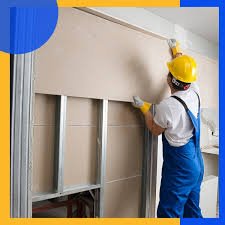In the dynamic world of commercial architecture and interior design, dry-wall systems have emerged as a game-changing solution. Whether constructing office buildings, shopping malls, hospitals, or educational institutions, dry-walls offer unparalleled advantages in terms of soundproofing, fire resistance, and flexibility in layout and design. These attributes are not only beneficial from a performance standpoint but also align with cost-efficiency, ease of installation, and sustainability goals.
As businesses increasingly seek adaptable and safe workspaces, understanding the different types of dry-wall systems—especially soundproof and fire-rated varieties—becomes essential. This comprehensive guide explores the characteristics, benefits, and selection criteria of dry-wall systems in commercial settings, helping stakeholders make informed decisions.
What are Dry-Wall Systems?
Dry-wall systems—commonly referred to as gypsum board or plasterboard systems—are prefabricated panels used to build non-load-bearing walls and ceilings. Unlike traditional wet construction methods involving brick and mortar, dry-walls require minimal water usage, hence the name.
In commercial environments, dry-wall systems are used for:
- Internal partitions
- Ceiling systems
- Duct enclosures
- Shaft walls
- Acoustic and fire-rated barriers
They are typically composed of a gypsum core sandwiched between paper liners, but advanced versions may include additives or specialized layers to enhance performance.
Importance of Soundproof Dry-Wall Systems in Commercial Spaces
Noise pollution is a significant concern in commercial spaces such as offices, clinics, and conference halls. Soundproof dry-wall systems help maintain acoustic privacy, improving productivity and comfort.
Key Benefits:
- Acoustic Isolation: These systems reduce sound transmission between rooms, measured using the Sound Transmission Class (STC) rating.
- Improved Productivity: In office settings, reduced background noise leads to better concentration and work output.
- Enhanced Privacy: Law firms, clinics, and corporate offices require private conversations, which soundproof dry-walls ensure.
- Tenant Satisfaction: In multi-tenant buildings, sound isolation boosts satisfaction and lease retention.
How Soundproof Dry-Walls Work:
- Use of double-layer boards
- Installation on resilient metal frames
- Insertion of insulation materials like mineral wool
- Incorporation of sound-dampening glue or viscoelastic polymers
Fire-Rated Dry-Wall Systems: Safety Comes First
In any commercial setup, fire safety is non-negotiable. Fire-rated dry-wall systems are designed to withstand high temperatures and prevent the spread of flames, giving occupants critical evacuation time.
Fire-Rating Explained:
Fire ratings are categorized based on how long a system can resist fire exposure:
- 30 minutes
- 60 minutes
- 90 minutes
- 120+ minutes
Components of a Fire-Rated Dry-Wall System:
- Fire-resistant gypsum boards with additives like fiberglass
- Steel studs for better fire resistance than wooden ones
- Joint treatment systems that seal gaps and resist fire
- Optional intumescent coatings
Applications:
- Server rooms
- Electrical panels
- Escape corridors
- Storage rooms with flammable materials
Flexibility and Design Adaptability in Commercial Spaces
Another hallmark of modern dry-wall systems is flexibility—the ability to quickly reconfigure spaces without major structural changes. This is particularly important in co-working spaces, retail outlets, and educational facilities that often undergo layout changes.
Benefits:
- Modular Design: Allows partitions to be easily moved, added, or removed.
- Time Efficiency: Faster remodeling reduces business downtime.
- Lightweight: Causes less structural load on the building.
- Eco-Friendly: Boards can often be reused or recycled.
Use Cases:
- Reconfigurable office cubicles
- Pop-up retail walls
- Temporary healthcare isolation rooms
- Education sector: adaptable classroom designs
Comparison Table: Soundproof vs. Fire-Rated vs. Flexible Dry-Wall Systems
| Feature | Soundproof Dry-Wall | Fire-Rated Dry-Wall | Flexible Dry-Wall |
| Primary Purpose | Acoustic insulation | Fire resistance | Space reconfiguration |
| Core Material | Gypsum with acoustic layers | Gypsum with fiberglass additives | Standard or lightweight gypsum |
| Additional Layers | Insulation, double boards | Multiple boards, steel framing | Minimal layers, modular framing |
| Installation Time | Moderate | Moderate | Fast and easy |
| STC Rating | 50+ | 30–40 | 30–35 |
| Fire Rating | 30 mins (standard) | 60–120 mins | 30 mins (standard) |
| Reusability | Moderate | Low | High |
| Cost | Medium to High | Medium to High | Low to Medium |
| Ideal Use Case | Offices, clinics, hotels | Server rooms, escape routes | Startups, co-working, retail |
Analysis of the Comparison Table
The comparison table highlights how different dry-wall systems serve varied commercial needs. Soundproof systems are ideal for environments requiring acoustic privacy, but they typically involve higher installation costs due to layered materials. Fire-rated dry-walls, on the other hand, are safety-critical installations used in high-risk zones like server rooms or storage facilities. Their strength lies in their fire-resistance duration, although they offer limited reusability.
In contrast, flexible dry-walls may lack specialized performance but shine in modular and evolving environments. Their affordability and ease of reconfiguration make them the preferred choice in modern workspaces and commercial interiors where change is constant.
How to Choose the Right Dry-Wall System
Choosing the best dry-wall system depends on several factors including budget, functional requirements, compliance regulations, and future use plans.
1. Assess Acoustic Needs
- Opt for high-STC rated systems in spaces like conference rooms or therapy centers.
- Consider additional insulation if external noise sources are significant.
2. Evaluate Fire Safety Requirements
- Check local building codes and fire compliance mandates.
- Use double-layered boards and steel studs for areas requiring high fire resistance.
3. Plan for Future Changes
- Select modular dry-wall designs in retail or startup environments where flexibility is critical.
- Look for systems that allow easy removal and repositioning without major construction work.
4. Budget Considerations
- Weigh the initial cost vs. long-term benefits like energy savings, reduced noise complaints, or safety assurance.
- Get quotes for both materials and professional installation to avoid surprises.
5. Choose the Right Contractor
- Work with professionals experienced in commercial-grade dry-wall installations.
- Ask for certifications, especially for fire-rated or acoustic systems.
FAQ: Dry-Wall Systems in Commercial Use
Q1: Can a single dry-wall system be both soundproof and fire-rated?
Yes, hybrid dry-wall systems are available that offer both sound insulation and fire resistance. These systems are ideal for multi-functional spaces like hospitals, educational institutions, or recording studios.
Q2: Are dry-walls strong enough to hang heavy equipment or TVs in commercial settings?
Standard dry-walls can support moderate loads with appropriate anchors, but for heavy equipment, it’s recommended to use reinforced backing or metal stud framing.
Q3: What is the lifespan of a commercial dry-wall system?
With proper maintenance and protection from moisture or impact, dry-wall systems can last 20–30 years or more in commercial settings.
Q4: Are dry-wall systems environmentally friendly?
Yes. Most modern gypsum boards are made from recycled content and are recyclable themselves. Additionally, dry construction reduces water waste compared to traditional masonry.
Q5: How long does it take to install dry-wall in a 1000 sq. ft commercial office?
Depending on complexity (soundproof/fire-rated), it typically takes 3 to 7 days, including finishing and painting.
Q6: Is it possible to retrofit existing brick walls with dry-wall panels for added insulation or aesthetics?
Yes. Dry-wall furring systems can be applied over existing walls to improve insulation, fire safety, and aesthetics without full reconstruction.
Conclusion: Creating Smarter, Safer Spaces with Dry-Wall Systems
In the evolving landscape of commercial design and construction, dry-wall systems stand out as versatile, cost-effective, and high-performance solutions. Whether your priority is sound control, fire safety, or space flexibility, there’s a specialized dry-wall system that can meet your needs.
Investing in the right type of dry-wall system enhances not just the safety and comfort of your commercial space, but also its operational efficiency and adaptability. As more businesses embrace modern infrastructure, these systems will continue to play a pivotal role in shaping the future of commercial interiors.
Ready to enhance your commercial space? Contact a professional contractor today to explore customized dry-wall systems that align with your business goals and safety requirements.






